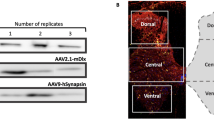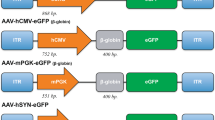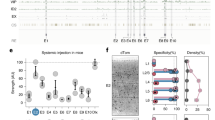Abstract
Neuron–restrictive silencer elements (NRSEs) were used to target the gene expression of adenoviral vectors specifically to neuron cells in the central nervous system. By generating adenoviral constructs in which NRSE sequences were placed upstream from the ubiquitous phosphoglycerate kinase promoter, the specificity of expression of a luciferase reporter gene was tested in both cell lines and primary cultures. Whereas transgene expression was negligible in nonneuronal cells following infection with an adenovirus containing 12 NRSEs, neuronal cells strongly expressed luciferase when infected with the same adenovirus. The NRSEs restricted expression of the luciferase gene to neuronal cells in vivo when adenoviruses were injected both intramuscularly into mice and intracerebrally into rats. This NRSE strategy may avoid side effects resulting from the ectopic expression of therapeutic genes in the treatment of neurological diseases. In particular, it may allow the direct transfection of motor neurons without promoting transgene expression within inoculated muscles or the secretion of transgene products into the bloodstream.
This is a preview of subscription content, access via your institution
Access options
Subscribe to this journal
Receive 12 print issues and online access
$209.00 per year
only $17.42 per issue
Buy this article
- Purchase on Springer Link
- Instant access to full article PDF
Prices may be subject to local taxes which are calculated during checkout






Similar content being viewed by others
References
Sendtner, M. Gene therapy for motor neuron disease. Nat. Med. 3, 380–381 (1997).
Le Gal La Salle, G. et al. An adenovirus vector for gene transfer into neurons and glia in the brain. Science 259, 988– 990 (1993).
Barkats, M. et al. Adenovirus in the brain: recent advances of gene therapy for neurodegenerative diseases. Prog. Neurobiol. 55, 333– 341 (1998).
Barkats, M. et al. Intrastriatal grafts of embryonic mesencephalic rat neurons genetically modified using an adenovirus encoding human Cu/Zn superoxide dismutase. Neuroscience 78, 703–713 (1997).
Horellou, P. et al. Direct intracerebral gene transfer of an adenoviral vector expressing tyrosine hydroxylase in a rat model of Parkinson's disease. Neuroreport 6, 49–53 (1994 ).
Bilang-Bleuel, A. et al. Intrastriatal injection of an adenoviral vector expressing glial-cell-line-derived neurotrophic factor prevents dopaminergic neuron degeneration and behavioral impairment in a rat model of Parkinson disease. Proc. Natl. Acad. Sci. USA 94, 8818–8823 ( 1997).
Haase, G. et al. Gene therapy of murine motor neuron disease using adenoviral vectors for neurotrophic factors. Nat. Med. 3, 429– 436 (1997).
Ghadge, G.D. et al. CNS gene delivery by retrograde transport of recombinant replication-defective adenoviruses. Gene Ther. 2, 132– 137 (1995).
Finiels, F. et al. Specific and efficient gene transfer strategy offers new potentialities for the treatment of motor neurone diseases. Neuroreport 6, 2473–2478 (1995).
Peel, A.L., Zolotukhin, S., Schrimsher, G.W., Muzyczka, N. & Reier, P.J. Efficient transduction of green fluorescent protein in spinal cord neurons using adeno-associated virus vectors containing cell type-specific promoters. Gene Ther. 4, 16–24 (1997).
Mori, N., Stein, R., Sigmund, O. & Anderson, D.J. A cell type-preferred silencer element that controls the neural-specific expression of the SCG10 gene. Neuron 4, 583– 594 (1990).
Maue, R.A., Kraner, S.D., Goodman, R.H. & Mandel, G. Neuron-specific expression of the rat brain type II sodium channel gene is directed by upstream regulatory sequence. Neuron 4, 223–231 (1990).
Mori, N., Schoenherr, C., Vandenbergh, D.J. & Anderson, D.J. A common silencer element in the SCG10 and type II Na+ channel genes binds a factor present in nonneuronal cells but not in neuronal cells. Neuron 9, 45–54 (1992).
Schoenherr, C.J. & Anderson, D.J. The neuron-restrictive silencer factor (NRSF): a coordinate repressor of multiple neuron-specific genes. Science 267, 1360– 1363 (1995).
Bessis, A., Champtiaux, N., Chatelin, L. & Changeux, J.P. The neuron-restrictive silencer element: a dual enhancer/silencer crucial for patterned expression of a nicotinic receptor gene in the brain. Proc. Natl. Acad. Sci. USA 94, 5906– 5911 (1997).
Moullier, P., Marechal, V., Danos, O. & Heard, J.M. Continuous systemic secretion of a lysosomal enzyme by genetically modified mouse skin fibroblasts. Transplantation 56, 427– 432 (1993).
McBurney, M.W. et al. The mouse Pgk-1 gene promoter contains an upstream activator sequence. Nucleic Acids Res. 19, 5755– 5761 (1991).
Kallunki, P., Jenkinson, S., Edelman, G.M. & Jones, F.S. Silencer elements modulate the expression of the gene for the neuron-glia cell adhesion molecule, Ng-CAM. J. Biol. Chem. 270, 21291–21298 (1995).
Chong, J.A. et al. REST: A mammalian silencer protein that restricts sodium channel gene expression to neurons. Cell. 80, 949 –957 (1995).
Wood, I.C., Roopra, A. & Buckley, N.J. Neural specific expression of the m4 muscarinic acetylcholine receptor gene is mediated by a RE1/NRSE-type silencing element. J. Biol. Chem. 271, 14221–14225 (1996).
Li, L., Suzuki, T., Mori, N. & Greengard, P. Identification of a functional silencer element involved in neuron-specific expression of the synapsin I gene. Proc. Natl. Acad. Sci. USA 90, 1460–1464 (1993).
Forss-Petter, S. et al. Transgenic mice expressing β-galactosidase in mature neurons under neuron-specific enolase promoter control. Neuron 5, 187–197 (1990).
Bessereau, J.L., Stratford-Perricaudet, L.D., Piette, J., Le Poupon, C. & Changeux, J.P. In vivo and in vitro analysis of electrical activity-dependent expression of muscle acetylcholine receptor genes using adenovirus. Proc. Natl. Acad. Sci. USA 91, 1304–1308 (1994).
Chen, H.H. et al. Persistence in muscle of an adenoviral vector that lack all viral genes. Proc. Natl. Acad. Sci. USA 94, 1645– 1650 (1997).
Anderson, W.F. Human gene therapy. Nature 392, 25S– 30S (1998).
Corti, O. et al. A single adenovirus vector mediates doxycycline-controlled expression of tyrosine hydroxylase in brain grafts of human neural progenitors. Nat. Biotechnol. 17, 349–354 ( 1999).
Stratford-Perricaudet, L.D., Makeh, I., Perricaudet, M. & Briand, P. Widespread long-term gene transfer to mouse skeletal muscles and heart. J. Clin. Invest. 90, 626–630 (1992).
Hawrot, E. & Patterson, P.H. Long-term culture of dissociated sympathetic neurons. Methods Enzymol. 58, 574–584 (1979).
Abercrombie M. Estimation of nuclear population from microtome section. Anat. Rec. 94, 239–247 ( 1946).
Acknowledgements
The authors thank Véronique Albanese, Fabienne Chatail, and Sylvie Dumas for helpful suggestions, and Sylvie Carpaille and Philippe Colin for handling the animals. S.M. was supported by Ministère de l'Education Nationale de l'Enseignement Supérieur et de la Recherche, H.K. by Institut de Formation Supérieure Biomédicale, and M.B. by the European Commission Biotechnology program. This work was supported in part by Association Française contre les Myopathies, Association Française Retinis Pigmentosa, Institut de Recherche sur la Moelle Epinière, Centre National de la Recherche Scientifique, Rhône-Poulenc Rorer, and the Conseil Régional d'Ile-de-France.
Author information
Authors and Affiliations
Corresponding author
Rights and permissions
About this article
Cite this article
Millecamps, S., Kiefer, H., Navarro, V. et al. Neuron-restrictive silencer elements mediate neuron specificity of adenoviral gene expression. Nat Biotechnol 17, 865–869 (1999). https://doi.org/10.1038/12849
Received:
Accepted:
Issue Date:
DOI: https://doi.org/10.1038/12849
This article is cited by
-
Silencer-delimited transgenesis: NRSE/RE1 sequences promote neural-specific transgene expression in a NRSF/REST-dependent manner
BMC Biology (2012)
-
Intravenous Administration of Self-complementary AAV9 Enables Transgene Delivery to Adult Motor Neurons
Molecular Therapy (2009)
-
A newly modified SCG10 promoter and Cre/loxP-mediated gene amplification system achieve highly specific neuronal expression in animal brains
Gene Therapy (2006)
-
A novel adenoviral vector which mediates hypoxia-inducible gene expression selectively in neurons
Gene Therapy (2005)
-
Human synapsin 1 gene promoter confers highly neuron-specific long-term transgene expression from an adenoviral vector in the adult rat brain depending on the transduced area
Gene Therapy (2003)



